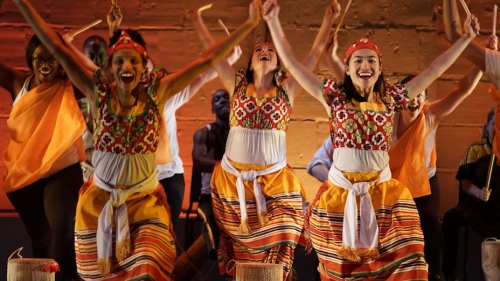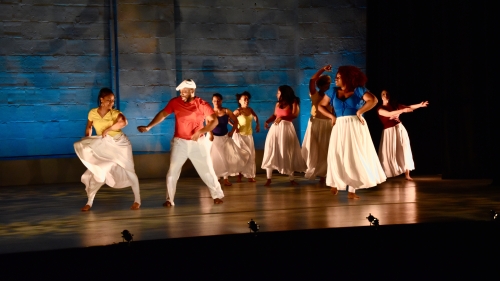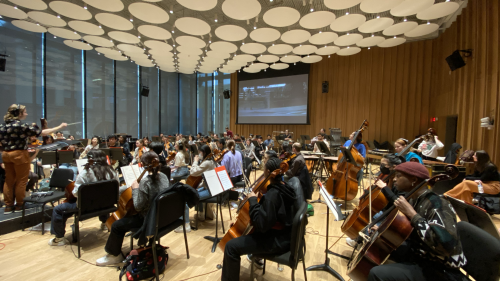While most graduate degrees in dance focus largely on European styles and backgrounds, NYU Steinhardt breaks the mold with the Dances of the African Diaspora concentration in its Master of Arts in Dance Education: Teaching Dance in the Professions program.
This concentration is an intensive study of the evolution of African diasporic dance that highlights the importance of understanding the culture behind these styles, as well as preparing students to be successful educators with strong pedagogical skills.
Making Space for Everyone
The Dances of the African Diaspora concentration grew out of a desire to center these styles, bringing them to the same prominence as the others that have been mainstream for decades or even centuries, such as contemporary and ballet.

“This program is ideal for students who want to learn more deeply about dances from their homes, cultures, and streets in a real way,” says Michelle Cole, adjunct faculty and advisor for the Dances of the African Diaspora concentration. “These styles have routinely been looked at as fun or social, but not culturally or professionally relevant. We want to provide students with an educational background and a theoretical framework to bring these dances to an elevated place by teaching them in schools.”
Kevin McEwen, an alum of Steinhardt’s foundational Teaching Dance in the Professions program, was instrumental in helping to create the Dances in the African Diaspora concentration.
“The Dances of the African Diaspora concentration is necessary because it makes space for dancers who have different passions outside of ballet and modern,” says McEwen, who teaches African and Afro Caribbean Dance at Queensborough Community College and helms a West African dance company called Kofago Dance Ensemble. “With this concentration, we’re trying to deconstruct the hierarchy and bring African dance forms up to equal footing with the others. It’s not about bringing other important forms like ballet and contemporary down; it’s about trying to make space for everyone.”
Research for an Embodied Practice

With a diverse range of faculty and lecturers teaching from dance-based and historical perspectives, students in this concentration learn from academic, pedagogical, and professional dance viewpoints. Beyond studying the movements of the dance forms, students also delve deeply into researching the backgrounds and cultural impacts of styles that interest them.
“Research allows for an embodied practice and the ability to perform both externally and internally,” says Cole. “Students gain a deeper respect for the dances, allowing them to educate others.”
Abeba Baptiste, a current student in the program, learned of the importance of such research during her “Anthropology of Dance” course, taught by Cole.
“The history of African dances was written by white men, which means it’s coming from their viewpoint and biases,” says Baptiste, who conducted research on Yanvalou, a traditional Afro-Haitian dance. “In research, you have to learn to strip away a lot of your own thinking because you’re entering the realm of people who are foreign to you.”
Baptiste met one-on-one with people from Haitian culture so she could learn from them the specific body movements in Yanvalou and the meanings they held – a practice she calls “an enriching experience.”
Hands-On Learning around the World

Students in the Dances of the African Diaspora concentration have many opportunities to practice their craft hands-on. They can participate with Kaleidoscope Dancers, a professional and academic service learning dance company in which students collaboratively design interactive lesson plans and performances with children in K–12 settings. NYU also offers a wealth of other performance opportunities, from ensembles to special programs commemorating Black History Month.
Students can also study abroad in Uganda. During the two-week trip, they collaborate with professional dancers, educators, and students from schools, community organizations, and local universities, as well as take classes in traditional Ugandan dance, East African drumming, and teaching methodology.

“Every center we work with is Ugandan-run, and they were often started by local kids who came back and created these organizations to promote performing arts as social change,” says Deborah Damast, director of the Dance Education program and a clinical associate professor. “Between the lesson planning and workshops and performances, we interact with approximately 1,000 people over those two weeks.”
“It is an amazing, life-changing experience,” says Cole. “Students go deep into the culture and spend an entire day dancing. We visit monumental places like the source of the Nile River and Ssezibwa Falls, but the collaboration with the other teachers and students is so impactful. It’s about both teaching and learning together, and it changes you.”
Is the Dances of the African Diaspora Program Right for You?

In another move to ensure inclusivity and equity in dance and dance education, Steinhardt no longer requires auditions for the Dances of the African Diaspora concentration.
“We want our students to have the creativity to go deeper into their dance practice and be reflective about it,” says Afaliah Tribune, adjunct faculty member and another advisor of the Dances of the African Diaspora concentration. “This program is much less about how technically advanced you are and more about being open to new experiences and being a catalyst for change.”
“We want applicants to this program to have a desire to transform,” says Damast. “They need to have a readiness to learn and a respect for the differences in dance forms, cultures, and people.”
Learn More and Apply Today
“I am so thankful for this concentration; it is so important to a lot of dancers from all walks of life,” says Baptise. “It’s especially beautiful that it’s happening in New York City among so many other cultures. This finally feels like a realm where you can be seen, and ensuring this community has a place in higher education is groundbreaking.”
Learn more about the Dances of the African Diaspora concentration in the Master of Arts in Dance Education: Teaching Dance in the Professions program and how to apply.

Music and Performing Arts Professions
35 W. 4th Street, 2nd Floor
New York, NY 10012
212-998-5424
mpap@nyu.edu
